
The piano is an acoustic, stringed musical instrument invented in Italy by Bartolomeo Cristofori around the year 1700, in which the strings are struck by felt hammers. It is played using a keyboard, which is a row of keys that the performer presses down or strikes with the fingers and thumbs of both hands to cause the hammers to strike the strings.
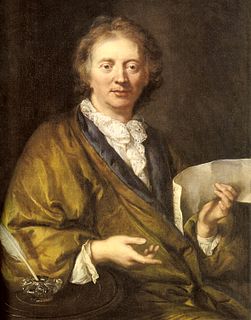
François Couperin was a French Baroque composer, organist and harpsichordist. He was known as Couperin le Grand to distinguish him from other members of the musically talented Couperin family.

A spinet is a smaller type of harpsichord or other keyboard instrument, such as a piano or organ.

The tangent piano is a very rare keyboard instrument that resembles a harpsichord and early pianos in design. It normally features five octaves of keys and the strings are acted upon by narrow wooden or metal slips when the keys are depressed.
Henri Arnaut de Zwolle was employed as a physician, astronomer, astrologer, and organist to Philip the Good. He is best known for a treatise on musical instruments.
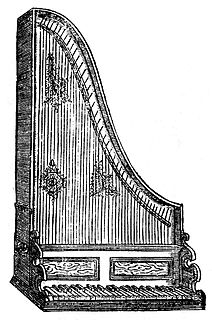
A clavicytherium is a harpsichord in which the soundboard and strings are mounted vertically facing the player. The primary purpose of making a harpsichord vertical is the same as in the later upright piano, namely to save floor space. In a clavicytherium, the jacks move horizontally without the assistance of gravity, so that clavicytherium actions are more complex than those of other harpsichords.

The viola organista is a musical instrument designed by Leonardo da Vinci. It uses a friction belt to vibrate individual strings, with the strings selected by pressing keys on a keyboard. Leonardo's design has intrigued instrument makers for more than 400 years, but though similar instruments have been built, no extant instrument constructed directly from Leonardo's incomplete designs is known. Sometimes it is mistakenly referred to as the harpsichord viola, which is a different instrument.

Gustav Leonhardt was a Dutch keyboard player, conductor, musicologist, teacher and editor. He was a leading figure in the movement to perform music on period instruments. Leonhardt professionally played many instruments, including the harpsichord, pipe organ, claviorganum, clavichord, fortepiano and piano. He also conducted orchestras and choruses.
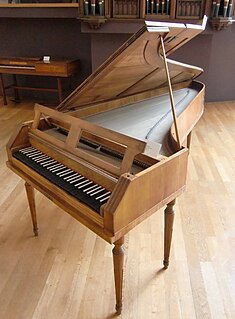
Johann (Georg) Andreas Stein, was an outstanding German maker of keyboard instruments, a central figure in the history of the piano. He was primarily responsible for the design of the so-called "Viennese" fortepiano, for which the piano music of Haydn, Mozart, and the early Beethoven was written.
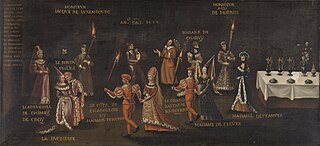
The Feast of the Pheasant was a banquet given by Philip the Good, Duke of Burgundy on 17 February 1454 in Lille, now in France. Its purpose was to promote a crusade against the Turks, who had taken Constantinople the year before. The crusade never took place.

Composer Paul-Henri-Joseph Lebrun (21 April 1863 – 4 November 1920) was a Belgian composer and professor at the Ghent Conservatory, who won the Belgian Prix de Rome for music in 1891.

The harpsichord was an important keyboard instrument in Europe from the 15th through the 18th centuries, and as revived in the 20th, is widely played today. This article gives a history of the harpsichord; for information on the construction of this instrument, its variant forms, and the music composed for it, see harpsichord.

Henri Dumont was a baroque composer of the French school, born in the Southern Netherlands.

The Well-Tempered Clavier, BWV 846–893, is a collection of two sets of preludes and fugues in all 24 major and minor keys, composed for solo keyboard by Johann Sebastian Bach. In Bach's time Clavier (keyboard) was a generic name indicating a variety of keyboard instruments, most typically a harpsichord or clavichord – but not excluding an organ either.

The claviharp is a 19th-century musical instrument that combined a harp with a keyboard. J. C. Dietz invented the instrument in 1813 CE. His grandfather was one of the first upright piano manufacturers. Struck by what he saw as difficulties and defects of the harp, in 1810, he built an instrument à cordes pincées à clavier, which connected a keyboard to the harp strings.
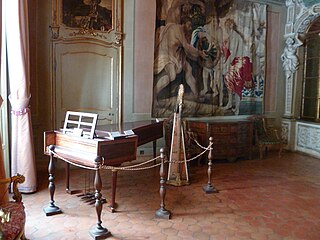
The Palais Lascaris is a seventeenth-century aristocratic building in Nice, France. Currently, it is a musical instrument museum. Located in the old town of Nice, it houses a collection of over 500 instruments, which makes it France’s second most important collection.
Geneviève Hasenohr is a French philologist and prolific scholar of medieval and Renaissance French literature. She has authored or contributed to more than forty books, written at least fifty academic articles and reviews, and prepared numerous scholarly editions.

The dulce melos is an early keyboard instrument and possible ancestor of the piano. The instrument is described as a type of zither, similar to a hammered dulcimer, but with the strings struck by hammers on keys. The instrument had twelve pairs of strings, each divided into three sections in a 4:2:1 ratio, resulting in a full chromatic octave of 36 notes, as each note is divided into two higher octaves by the bridges. Among the instrument's first attestations was a 1440 work by Henri-Arnault de Zwolle.
Johann Sebastian Bach's music has been performed by musicians of his own time, and in the second half of the eighteenth century by his sons and students, and by the next generations of musicians and composers such as the young Beethoven. Felix Mendelssohn renewed the attention for Bach's music by his performances in the 19th century. In the 20th century Bach's music was performed and recorded by artists specializing in the music of the composer, such as Albert Schweitzer, Helmut Walcha and Karl Richter. With the advent of the historically informed performance practice Bach's music was prominently featured by artists such as Nikolaus Harnoncourt, Gustav Leonhardt and Sigiswald Kuijken.

Albert Delin was a Flemish harpsichord maker.

















